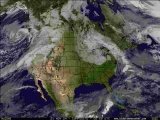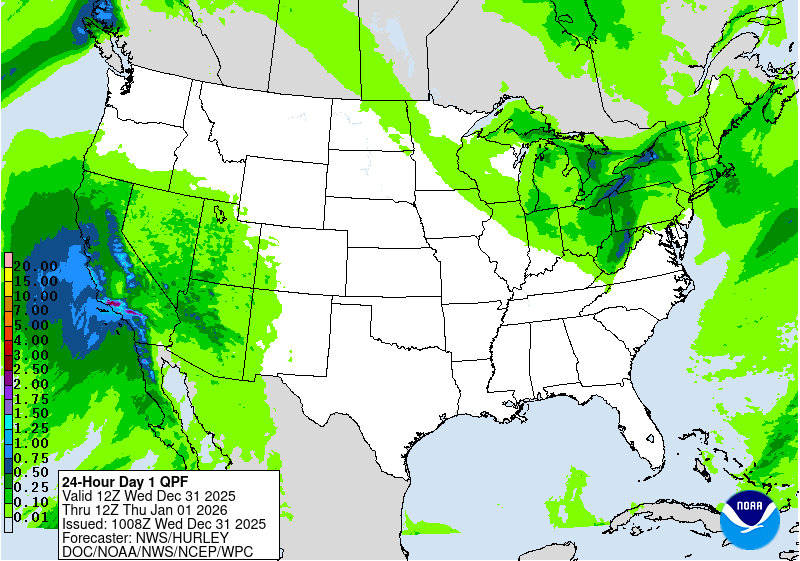|
U.S. Day 1 Fire Weather Outlook
ZCZC SPCFWDDY1 ALL
FNUS21 KWNS 011655
Day 1 Fire Weather Outlook
NWS Storm Prediction Center Norman OK
1155 AM CDT Tue Jul 01 2025
Valid 011700Z - 021200Z
...CRITICAL FIRE WEATHER AREA FOR SOUTHERN AND CENTRAL NEVADA...
...Northern California...
Isolated dry thunderstorm threat was extended farther south along
the California coastal range with thunderstorm development expected
just north of Napa Valley this afternoon. Similarly, thermodynamic
profiles over the northern Sierra suggests convective development
just north of Lake Tahoe later today, moving into northeastern
California and southern Oregon through the afternoon and evening
hours.
...Southern/Central Nevada...
Critical fire weather conditions with sustained southerly winds of
15-20 mph and daytime relative humidity of 10-15% amid dry fuels
will increase wildfire spread potential across central and southern
Nevada today.
Otherwise, previous forecast (see below) remains largely on track
with additional high-based showers and thunderstorms with potential
lightning ignitions amid receptive fuels over the higher terrain of
northwest Arizona, central Utah into the Upper Snake River Plain and
far southwest Wyoming.
..Williams.. 07/01/2025
.PREV DISCUSSION... /ISSUED 0119 AM CDT Tue Jul 01 2025/
...Synopsis...
An amplified upper trough slowly progressing eastward across central
California will be responsible for supporting mixed dry/wet
thunderstorms across portions of northern California into southern
Oregon, critical fire-weather conditions across portions of southern
and central Nevada, and for pushing enough monsoonal moisture into
portions of Arizona, Utah, and southeastern Idaho to support
lightning over dry fuels.
...Central/Southern Nevada...
Deep boundary layer mixing below strong meridional mid-level flow
will result in dry and windy conditions that overlap with fuels
receptive to wildfire spread (ERCs at or exceeding the 90th annual
percentile). Relative humidity of 5-10% coupled with 25 MPH winds,
possibly gusting to 30 MPH, are anticipated across portions of
central and southern Nevada -- warranting the introduction of
Critical highlights.
...Dry Thunderstorms...
A mix of wet/dry thunderstorms are anticipated across portions of
northern California into southern and eastern Oregon. Thunderstorms
are expected to develop within deep inverted-v boundary-layer
profiles with total precipitable water content between 0.5 - 0.75
in, and 0 - 6 km mean wind speeds of 15-20 MPH. With ERC percentiles
climbing to the 70th-80th annual percentiles, lightning over dry
fuels with little wetting precipitation will pose a fire-weather
risk.
Further east across portions of northern Arizona, western/central
Utah, and far southeastern Idaho, a mix of wet and dry thunderstorms
is expected. ERC fuel percentiles are more significant across this
region, ranging from the 90th annual percentiles to exceeding the
98th annual percentiles across large portions of the region. With
total precipitable water vapor content forecast between 0.5 and 0.8
inches resulting in lower precipitation efficiency, dry lightning
ignitions will be possible.
|
U.S. Day 2 Fire Weather Outlook
ZCZC SPCFWDDY2 ALL
FNUS22 KWNS 011859
Day 2 Fire Weather Outlook
NWS Storm Prediction Center Norman OK
0159 PM CDT Tue Jul 01 2025
Valid 021200Z - 031200Z
...Northwest...
A mid-level trough and attendant accelerating mid-level flow will
support stronger onshore flow into western OR/WA. Stronger gap winds
through the Columbia Gorge along with enhanced downslope drying into
the Columbia Basin will bring elevated fire weather conditions to
the area Wednesday in conjunction with dry fuels. Thunderstorm
development is expected again Wednesday across northern CA into
southeastern/eastern OR. Northeast storm motions to the northeast of
25-30 mph will limit precipitation duration although ignition
efficiency may be limited owing to limited fuel receptiveness,
precluding dry thunderstorm highlights for Wednesday.
..Williams.. 07/01/2025
.PREV DISCUSSION... /ISSUED 0120 AM CDT Tue Jul 01 2025/
...Synopsis...
A mid-level trough slowly progressing across portions of central
California will continue to provide southerly transport of monsoon
moisture into portions of the Great Basin on Wednesday, while a
shortwave trough located further north over British Columbia will
provide support for dry/windy conditions across northern Oregon into
southern Washington.
...Dry/Windy...
Modest mid-level westerly/southwesterly flow, coupled with deep
mixing of dry boundary layer profiles, will support at least
Elevated fire-weather conditions across portions of northern Oregon
into southern Washington. The strongest winds will be confined to
portions of the Cascade gaps/Columbia Gorge, with ERCs across the
region nearing or meeting the annual 90th percentiles.
...Dry Thunderstorms...
A mix of wet and dry thunderstorms will be possible from
east-central Nevada into western Utah, and portions of far southeast
Idaho into far western Wyoming. Fuels across significant portions of
the Great Basin exceed the 98th annual percentiles, and a
combination of low to modest total precipitable water vapor content
and 0 - 6 km mean wind speeds ranging from 15 - 25 MPH will result
in low precipitation efficiency with thunderstorm updrafts. This
will support potential lightning ignitions, particularly with fast
moving cells and on the edges of the most intense downdraft cores.
U.S. Day 3-8 Fire Weather Outlook
ZCZC SPCFWDD38 ALL
FNUS28 KWNS 012056
Day 3-8 Fire Weather Outlook
NWS Storm Prediction Center Norman OK
0356 PM CDT Tue Jul 01 2025
Valid 031200Z - 091200Z
...Days 3-5/Thursday-Saturday...
An upper-level ridge will shift eastward from the Intermountain West
into the eastern U.S. through Day 5/Saturday while an upper-level
trough and cooler temperatures move into the Pacific Northwest,
mitigating fire weather concerns into the weekend. A mid-level
short-wave trough ejects into the Great Basin Days
3-4/Thursday-Friday bringing a period of stronger downslope flow
into western Nevada on Thursday, increasing the fire weather threat
amid drying fuels. A 50-60 knot mid-level jet associated with the
short-wave and an increasingly dry boundary layer will also support
stronger southwest winds across the southern Great Basin, increasing
wildfire spread potential. A mix of diurnally driven wet/dry
thunderstorms across the Intermountain West within a residual
monsoon moisture plume will decrease in coverage from west to east
as a dry southwest flow pattern is established across the Southwest.
...Days 6-8/Sunday-Tuesday...
Dry southwest flow aloft will keep monsoon moisture and associated
daytime convection primarily along the Continental Divide on Day
6/Sunday. A return of monsoon moisture into Lower Colorado River
Basin could return by Day 8/Tuesday in response to a nascent Four
Corners High, but forecast uncertainty in timing of moisture return
precludes introduction of critical probabilities at this time.
..Williams.. 07/01/2025
|
|





















































































